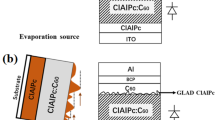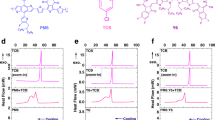Abstract
Using combinatory photoactive blends is a promising approach to achieve high power conversion efficiency in ternary organic photovoltaics. However, the fundamental challenge of how to manipulate the morphology of multiple components and correlate structure details via device performance has not been well addressed. Achieving an ideal morphology that simultaneously enhances charge generation and transport and reduces voltage loss is an imperative avenue to improve device efficiency. Here, we achieve a high power conversion efficiency of 13.20 ± 0.25% for ternary solar cells by using a combination of small molecules with both fullerene and non-fullerene acceptors, which form a hierarchical morphology consisting of a PCBM transporting highway and an intricate non-fullerene phase-separated pathway network. Carrier generation and transport find an optimized balance, and voltage loss is simultaneously reduced. Such a morphology fully utilizes the individual advantages of both fullerene and non-fullerene acceptors, demonstrating their indispensability in organic photovoltaics.
This is a preview of subscription content, access via your institution
Access options
Access Nature and 54 other Nature Portfolio journals
Get Nature+, our best-value online-access subscription
$29.99 / 30 days
cancel any time
Subscribe to this journal
Receive 12 digital issues and online access to articles
$119.00 per year
only $9.92 per issue
Buy this article
- Purchase on Springer Link
- Instant access to full article PDF
Prices may be subject to local taxes which are calculated during checkout





Similar content being viewed by others
Data availability
The data that support the plots within this paper and other findings of this study are available from the corresponding authors upon reasonable request.
References
Lu, L., Kelly, M. A., You, W. & Yu, L. Status and prospects for ternary organic photovoltaics. Nat. Photon. 9, 491–500 (2015).
Cheng, P. & Zhan, X. Versatile third components for efficient and stable organic solar cells. Mater. Horiz. 2, 462–485 (2015).
Ameri, T., Khoram, P., Min, J. & Brabec, C. J. Organic ternary solar cells: a review. Adv. Mater. 25, 4245–4266 (2013).
Gasparini, N. et al. Designing ternary blend bulk heterojunction solar cells with reduced carrier recombination and a fill factor of 77%. Nat. Energy 1, 16118 (2016).
Yang, Y. et al. High-performance multiple-donor bulk heterojunction solar cells. Nat. Photon. 9, 190–198 (2015).
Lu, L., Xu, T., Chen, W., Landry, E. S. & Yu, L. Ternary blend polymer solar cells with enhanced power conversion efficiency. Nat. Photon. 8, 716–722 (2014).
Huang, J.-S. et al. Polymer bulk heterojunction solar cells employing Förster resonance energy transfer. Nat. Photon. 7, 479–485 (2013).
Baran, D. et al. Reducing the efficiency–stability–cost gap of organic photovoltaics with highly efficient and stable small molecule acceptor ternary solar cells. Nat. Mater. 16, 363–369 (2017).
Kumari, T., Lee, S. M., Kang, S.-H., Chen, S. & Yang, C. Ternary solar cells with a mixed face-on and edge-on orientation enable an unprecedented efficiency of 12.1%. Energy Environ. Sci. 10, 258–265 (2017).
Xu, X. et al. highly efficient ternary-blend polymer solar cells enabled by a nonfullerene acceptor and two polymer donors with a broad composition tolerance. Adv. Mater. 29, 1704271 (2017).
Ryno, S. M., Ravva, M. K., Chen, X., Li, H. & Brédas, J.-L. Molecular understanding of fullerene–electrondonor interactions in organic solar cells. Adv. Energy Mater. 7, 1601370 (2017).
Liu, T. & Troisi, A. What makes fullerene acceptors special as electron acceptors in organic solar cells and how to replace them. Adv. Mater. 25, 1038–1041 (2013).
Lin, Y. & Zhan, X. Non-fullerene acceptors for organic photovoltaics: an emerging horizon. Mater. Horiz. 1, 470–488 (2014).
Nielsen, C. B., Holliday, S., Chen, H. Y., Cryer, S. J. & McCulloch, I. Non-fullerene electron acceptors for use in organic solar cells. Acc. Chem. Res. 48, 2803–2812 (2015).
Yan, H. et al. A high-mobility electron-transporting polymer for printed transistors. Nature 457, 679–686 (2009).
Veldman, D., Meskers, S. C. J. & Janssen, R. A. J. The energy of charge-transfer states in electron donor–acceptor blends: insight into the energy losses in organic solar cells. Adv. Funct. Mater. 19, 1939–1948 (2009).
Kawashima, K., Tamai, Y., Ohkita, H., Osaka, I. & Takimiya, K. High-efficiency polymer solar cells with small photon energy loss. Nat. Commun. 6, 10085 (2015).
Gao, K. et al. Deep absorbing porphyrin small molecule for high-performance organic solar cells with very low energy losses. J. Am. Chem. Soc. 137, 7282–7285 (2015).
Menke, S. M., Ran, N. A., Bazan, G. C. & Friend, R. H. Understanding energy loss in organic solar cells: toward a new efficiency regime. Joule 2, 25–35 (2018).
Liu, J. et al. Fast charge separation in a non-fullerene organic solar cell with a small driving force. Nat. Energy 1, 16089 (2016).
Collins, S. D., Ran, N. A., Heiber, M. C. & Nguyen, T.-Q. Small is powerful: recent progress in solution-processed small molecule solar cells. Adv. Energy Mater. 7, 1602242 (2017).
Deng, D. et al. Fluorination-enabled optimal morphology leads to over 11% efficiency for inverted small-molecule organic solar cells. Nat. Commun. 7, 13740 (2016).
Zhang, Q. et al. Small-molecule solar cells with efficiency over 9%. Nat. Photon. 9, 35–41 (2015).
Sun, Y. et al. Solution-processed small-molecule solar cells with 6.7% efficiency. Nat. Mater. 11, 44–48 (2011).
Xu, S. et al. An electron-rich 2-alkylthieno[3,4-b]thiophene building block with excellent electronic and morphological tunability for high-performance small-molecule solar cells. J. Mater. Chem. A 4, 17354–17362 (2016).
Liu, F. et al. A thieno[3,4-b]thiophene-based non-fullerene electron acceptor for high-performance bulk-heterojunction organic solar cells. J. Am. Chem. Soc. 138, 15523–15526 (2016).
Liu, F. et al. Efficient semitransparent solar cells with high NIR responsiveness enabled by a small-bandgap electron acceptor. Adv. Mater. 29, 1606574 (2017).
Xu, S. J. et al. A twisted thieno[3,4-b]thiophene-based electron acceptor featuring a 14-π-electron indenoindene core for high-performance organic Photovoltaics. Adv. Mater. 29, 1704510 (2017).
Zhang, C. & Zhu, X. Thieno[3,4-b]thiophene-based novel small-molecule optoelectronic materials. Acc. Chem. Res. 50, 1342–1350 (2017).
Liu, F. et al. Multifaceted regioregular oligo(thieno[3,4-b]thiophene)s enabled by tunable quinoidization and reduced energy band gap. J. Am. Chem. Soc. 137, 10357–10366 (2015).
Sun, K. et al. A molecular nematic liquid crystalline material for high-performance organic photovoltaics. Nat. Commun. 6, 6013 (2015).
Zhao, W. et al. Molecular optimization enables over 13% efficiency in organic solar cells. J. Am. Chem. Soc. 139, 7148–7151 (2017).
Cui, C. et al. High-performance organic solar cells based on a small molecule with alkylthio-thienyl-conjugated side chains without extra treatments. Adv. Mater. 27, 7469–7475 (2015).
Zhao, J. et al. Efficient organic solar cells processed from hydrocarbon solvents. Nat. Energy 1, 15027 (2016).
Chen, W., Nikiforov, M. P. & Darling, S. B. Morphology characterization in organic and hybrid solar cells. Energy Environ. Sci. 5, 8045–8074 (2012).
Gao, K. et al. Multi-length-scale morphologies driven by mixed additives in porphyrin-based organic photovoltaics. Adv. Mater. 28, 4727–4733 (2016).
Chen, W. et al. Hierarchical nanomorphologies promote exciton dissociation in polymer/fullerene bulk heterojunction solar cells. Nano. Lett. 11, 3707–3713 (2011).
Liu, F. et al. Relating chemical structure to device performance via morphology control in diketopyrrolopyrrole-based low band gap polymers. J. Am. Chem. Soc. 135, 19248–19259 (2013).
Jiang, K. et al. Multiple cases of efficient nonfullerene ternary organic solar cells enabled by an effective morphology control method. Adv. Energy Mater. 8, 1701370 (2018).
Pröller, S. et al. Following the morphology formation in situ in printed active layers for organic solar cells. Adv. Energy Mater. 5, 1501580 (2015).
Proctor, C. M., Kuik, M. & Nguyen, T.-Q. Charge carrier recombination in organic solar cells. Prog. Polym. Sci. 38, 1941–1960 (2013).
Cowan, S. R., Roy, A. & Heeger, A. J. Recombination in polymer-fullerene bulk heterojunction solar cells. Phys. Rev. B 82, 245207 (2010).
Vandewal, K., Tvingstedt, K., Gadisa, A., Inganäs, O. & Manca, J. V. Relating the open-circuit voltage to interface molecular properties of donor: acceptor bulk heterojunction solar cells. Phys. Rev. B 81, 125204 (2010).
Yao, J. et al. Quantifying losses in open-circuit voltage in solution-processable solar cells. Phys. Rev. Applied 4, 014020 (2015).
Rao, A. et al. The role of spin in the kinetic control of recombination in organic photovoltaics. Nature 500, 435–439 (2013).
Vandewal, K., Tvingstedt, K., Gadisa, A., Inganäs, O. & Manca, J. V. On the origin of the open-circuit voltage of polymer-fullerene solar cells. Nat. Mater. 8, 904–909 (2009).
Duan, C., Huang, F. & Cao, Y. Solution processed thick film organic solar cells. Polym. Chem. 6, 8081–8098 (2015).
Liu, X. et al. Low band gap conjugated polymers combining siloxane-terminated side chains and alkyl side chains: side-chain engineering achieving a large active layer processing window for PCE > 10% in polymer solar cells. J. Mater. Chem. A 5, 17619–17631 (2017).
Gasparini, N. et al. High-performance ternary organic solar cells with thick active layer exceeding 11% efficiency. Energy Environ. Sci. 10, 885–892 (2017).
Liu, F. et al. Printing fabrication of bulk heterojunction solar cells and in situ morphology characterization. J. Vis. Exp. 119, e53710 (2017).
Acknowledgements
We thank the National Basic Research Program of China (Program 973) (No. 2014CB643502), the National Key R&D Program of China (2017YFA0204700), the Strategic Priority Research Program of the Chinese Academy of Sciences (XDB12010200) and the National Natural Science Foundation of China (21572234, 21661132006) for their financial support. Portions of this research were carried out at beamlines 7.3.3 and 11.0.1.2 at the Advanced Light Source and Molecular Foundry at the Lawrence Berkeley National Laboratory, which was supported by the Department of Energy (DOE), Office of Science and Office of Basic Energy Sciences. Y.J. and F.Z. acknowledge financial support from the Swedish Research Council (VR621-2013-5561), the Swedish Government Strategic Research Area in Material Science on Functional Materials at Linköping University (Faculty Grant SFO-Mat-LiU No 200900971) and the China Scholarship Council (CSC201606920028).
Author information
Authors and Affiliations
Contributions
Z.Z. and Q.Y. fabricated and optimized the devices; S.X. synthesized the NITI; J.S., Y.Q. and F.L. performed the morphology characterization and analysis; Y.J. performed the photoluminescence, electroluminescence and FTPS-EQE experiments, which were supervised by F.Z.; and X.Z. conceived and directed the project. All authors discussed the results and substantially contributed to the preparation of the manuscript.
Corresponding authors
Ethics declarations
Competing interests
The authors declare no competing interests.
Additional information
Publisher’s note: Springer Nature remains neutral with regard to jurisdictional claims in published maps and institutional affiliations.
Supplementary information
Supplementary Information
Supplementary Tables 1–10, Supplementary Figures 1–20, Supplementary References
Rights and permissions
About this article
Cite this article
Zhou, Z., Xu, S., Song, J. et al. High-efficiency small-molecule ternary solar cells with a hierarchical morphology enabled by synergizing fullerene and non-fullerene acceptors. Nat Energy 3, 952–959 (2018). https://doi.org/10.1038/s41560-018-0234-9
Received:
Accepted:
Published:
Issue Date:
DOI: https://doi.org/10.1038/s41560-018-0234-9
This article is cited by
-
Efficient all-small-molecule organic solar cells processed with non-halogen solvent
Nature Communications (2024)
-
Rational molecular and device design enables organic solar cells approaching 20% efficiency
Nature Communications (2024)
-
Suppressing electron-phonon coupling in organic photovoltaics for high-efficiency power conversion
Nature Communications (2023)
-
Origins of the open-circuit voltage in ternary organic solar cells and design rules for minimized voltage losses
Nature Energy (2023)
-
Models and mechanisms of ternary organic solar cells
Nature Reviews Materials (2023)



